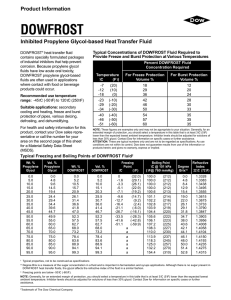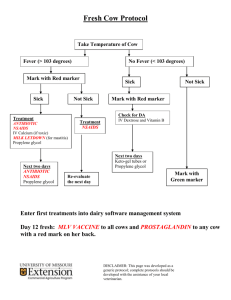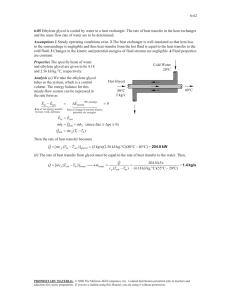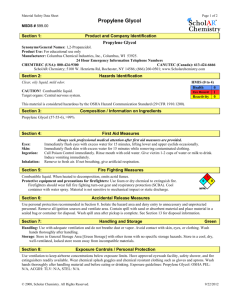PETROFLO HVAC-711 Heat Transfer Fluid - Petro
advertisement
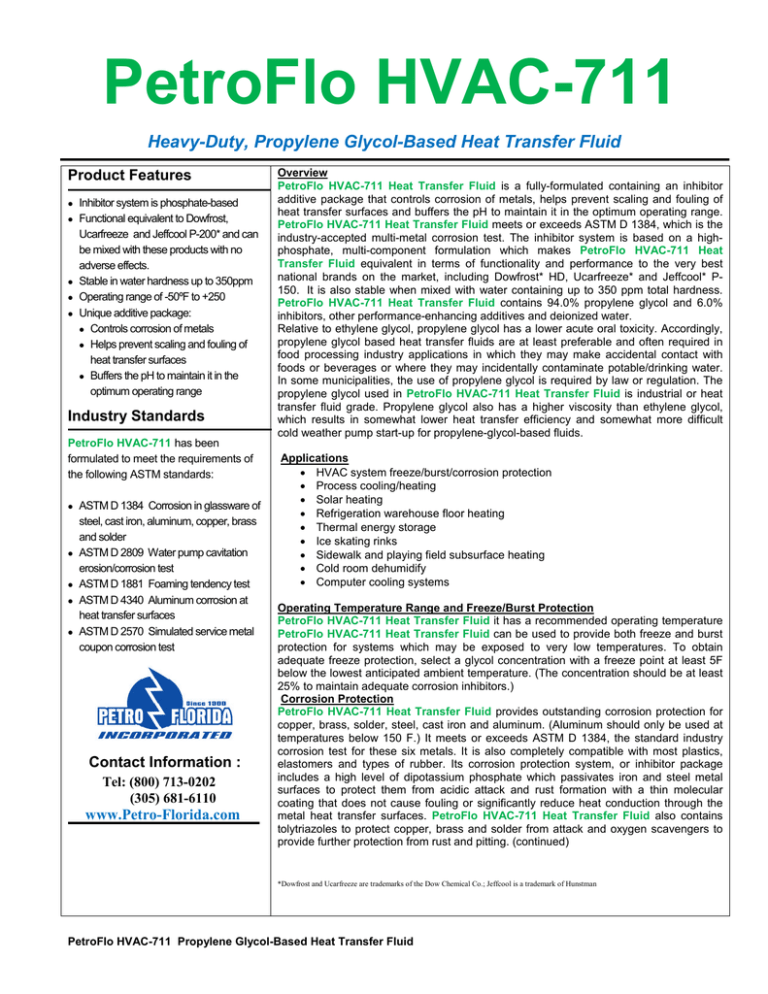
PetroFlo HVAC-711 Heavy-Duty, Propylene Glycol-Based Heat Transfer Fluid Product Features Inhibitor system is phosphate-based Functional equivalent to Dowfrost, Ucarfreeze and Jeffcool P-200* and can be mixed with these products with no adverse effects. Stable in water hardness up to 350ppm Operating range of -50ºF to +250 Unique additive package: Controls corrosion of metals Helps prevent scaling and fouling of heat transfer surfaces Buffers the pH to maintain it in the optimum operating range Industry Standards PetroFlo HVAC-711 has been formulated to meet the requirements of the following ASTM standards: ASTM D 1384 Corrosion in glassware of steel, cast iron, aluminum, copper, brass and solder ASTM D 2809 Water pump cavitation erosion/corrosion test ASTM D 1881 Foaming tendency test ASTM D 4340 Aluminum corrosion at heat transfer surfaces ASTM D 2570 Simulated service metal coupon corrosion test Contact Information : Tel: (800) 713-0202 (305) 681-6110 www.Petro-Florida.com Overview PetroFlo HVAC-711 Heat Transfer Fluid is a fully-formulated containing an inhibitor additive package that controls corrosion of metals, helps prevent scaling and fouling of heat transfer surfaces and buffers the pH to maintain it in the optimum operating range. PetroFlo HVAC-711 Heat Transfer Fluid meets or exceeds ASTM D 1384, which is the industry-accepted multi-metal corrosion test. The inhibitor system is based on a highphosphate, multi-component formulation which makes PetroFlo HVAC-711 Heat Transfer Fluid equivalent in terms of functionality and performance to the very best national brands on the market, including Dowfrost* HD, Ucarfreeze* and Jeffcool* P150. It is also stable when mixed with water containing up to 350 ppm total hardness. PetroFlo HVAC-711 Heat Transfer Fluid contains 94.0% propylene glycol and 6.0% inhibitors, other performance-enhancing additives and deionized water. Relative to ethylene glycol, propylene glycol has a lower acute oral toxicity. Accordingly, propylene glycol based heat transfer fluids are at least preferable and often required in food processing industry applications in which they may make accidental contact with foods or beverages or where they may incidentally contaminate potable/drinking water. In some municipalities, the use of propylene glycol is required by law or regulation. The propylene glycol used in PetroFlo HVAC-711 Heat Transfer Fluid is industrial or heat transfer fluid grade. Propylene glycol also has a higher viscosity than ethylene glycol, which results in somewhat lower heat transfer efficiency and somewhat more difficult cold weather pump start-up for propylene-glycol-based fluids. Applications HVAC system freeze/burst/corrosion protection Process cooling/heating Solar heating Refrigeration warehouse floor heating Thermal energy storage Ice skating rinks Sidewalk and playing field subsurface heating Cold room dehumidify Computer cooling systems Operating Temperature Range and Freeze/Burst Protection PetroFlo HVAC-711 Heat Transfer Fluid it has a recommended operating temperature PetroFlo HVAC-711 Heat Transfer Fluid can be used to provide both freeze and burst protection for systems which may be exposed to very low temperatures. To obtain adequate freeze protection, select a glycol concentration with a freeze point at least 5F below the lowest anticipated ambient temperature. (The concentration should be at least 25% to maintain adequate corrosion inhibitors.) Corrosion Protection PetroFlo HVAC-711 Heat Transfer Fluid provides outstanding corrosion protection for copper, brass, solder, steel, cast iron and aluminum. (Aluminum should only be used at temperatures below 150 F.) It meets or exceeds ASTM D 1384, the standard industry corrosion test for these six metals. It is also completely compatible with most plastics, elastomers and types of rubber. Its corrosion protection system, or inhibitor package includes a high level of dipotassium phosphate which passivates iron and steel metal surfaces to protect them from acidic attack and rust formation with a thin molecular coating that does not cause fouling or significantly reduce heat conduction through the metal heat transfer surfaces. PetroFlo HVAC-711 Heat Transfer Fluid also contains tolytriazoles to protect copper, brass and solder from attack and oxygen scavengers to provide further protection from rust and pitting. (continued) *Dowfrost and Ucarfreeze are trademarks of the Dow Chemical Co.; Jeffcool is a trademark of Hunstman PetroFlo HVAC-711 Propylene Glycol-Based Heat Transfer Fluid PetroFlo HVAC-711 Heat Transfer Fluid A very effective buffering system neutralizes acids formed by the normal thermal and oxidative degradation of glycols, thus maintaining the pH in its optimum range. Additives that control scaling and fouling also help prevent corrosion that occurs below water hardness scale deposits and minimizes coatings that reduce heat transfer rates. Water Quality Requirements We recommend using deionized or distilled water for dilution. However, tap water, well water, or city water may be used when it meets the quality standards. Your Product contains ingredients that help prevent water hardness compounds, such as calcium and magnesium carbonates and sulfates, from reacting with the inhibitor/additive package ingredients to form precipitates, which can reduce corrosion-protection capabilities and can form corrosion-promoting and heat-transfer-limiting deposits. However, it is still recommended that water with no more than 350 ppm hardness be used to dilute Your Product concentrate or be used as make-up water. Chlorides and sulfates are also usually present in municipal water sources. Both should be limited to concentrations no greater than 50 ppm. Characteristics Using Propylene Glycol Composition (Concentration) Propylene glycol 94.0 volume % min. Inhibitors & deionized water 6.0 volume % max. Color Colorless pH 50% solution 9.0-10.8 Specific Gravity (60°F) 94% solution 50% solution 1.045 min. 1.020 min. Reserve Alkalinity 94% solution 50% solution 12.0 ml. min. 6.0 ml. min. Flash Point 94% solution 50% solution 215°F min. none Vol. % Propylene Glycol Vol. % PetroFlo HVAC-711 Freezing Point °F Boiling Point °F @ 760 mm Hg 20 30 40 50 60 20.3 30.7 41.4 52.2 62.7 (19.2) (9.2) -6.0 -28.3 -59.9 213 216 219 222 225 Typical Concentrations of HVAC-711 Fluid Required to Provide Freeze and Burst Protection at Various Temperatures. NOTE: These figures are examples only and may not be appropriate to your situation. Generally, for an extended margin of protection, you should select a temperature in this table that is at least 3C (51`) lower than the expected lowest ambient temperature. Inhibitor levels should be adjusted for solutions of less than 30% glycol. ATTENTION: These are typical numbers only and are not to be regarded as specifications. As use conditions are not within its control, Petro-Florida does not guarantee results from use of the information or products herein; and gives no warranty, express or implied. PetroFlo HVAC-711 Propylene Glycol-Based Heat Transfer Fluid
